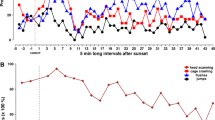Abstract
When released after clock-shift, homing pigeons fail to orient towards the home direction but display a consistent deflection of their initial orientation due to the difference between the real sun azimuth and the computed azimuth according to the subjective time of each single bird. It has been reported that the size of the observed deflection is frequently smaller than expected and a discussion on the possible factors affecting the size of deflection has emerged. Some authors have proposed that the major factor in reducing the deflection after clock-shift is the simultaneous use of both the magnetic and the sun compasses, giving true and erroneous information, respectively, about the home direction. Therefore, a magnetic disturbance, by impeding the use of the geomagnetic information in determining the home direction, is presumed to increase the size of the deflection up to the levels of the expectation. To test this hypothesis, we released three groups of clock-shifted birds from unfamiliar locations (unmanipulated pigeons, pigeons bearing magnets on their head, and pigeons bearing magnets on their back) together with a group of unshifted control birds. As no difference in the orientation of the three groups emerged, we were not able to confirm the hypothesis of the role of the magnetic compass in reducing the expected deflection after clock-shift.

Similar content being viewed by others
References
Batschelet E (1981) Circular Statistics in Biology. Academic, London
Bingman VP, Ioalè P (1989) Initial orientation of anosmic homing pigeons based on information gathered at familiar release sites remains homeward directed following clock-shift. Behaviour 110:1–4
Bonadonna F, Holland R, Dall’Antonia L, Guilford T, Benvenuti S (2000) Tracking clock-shifted homing pigeons from familiar release sites. J Exp Biol 203:207–212
Foà A, Albonetti E (1980) Does familiarity with the release site influence the initial orientation of homing pigeons? Experiments with clock-shifted birds. Z Tier 54:327–338
Füller E, Kowalski U, Wiltschko R (1983) Orientation of homing pigeons: compass orientation vs piloting by familiar landmarks. J Comp Physiol 153:55–58
Gagliardo A, Ioalè P, Bingman VP (1999) Homing in pigeons: the role of the hippocampal formation in the representation of landmarks used for navigation. J Neurosci 19:311–315
Gagliardo A, Ioalè P, Odetti F, Kahn MC, Bingman VP (2004) Hippocampal lesions do not disrupt navigational map retention in homing pigeons under conditions when map acquisition is hippocampal dependent. Behav Brain Res 153:35–42
Gagliardo A, Odetti F, Ioalè P (2005) Factors reducing the expected deflection in initial orientation in clock-shifted homing pigeons. J Exp Biol 208:469–478
Holland R (2003) The role of visual landmarks in the avian familiar area map. J Exp Biol 206:1773–1778
Holland R, Bonadonna F, Dall’Antonia L, Benvenuti S, Burt De Pereira T, Guilford T (2000) Short distance phase shifts revisited: tracking clock-shifted homing pigeons (Rock Dove Columba livia) close to the loft. Ibis 142:111–118
Ioalè P (1984) Magnets and pigeon orientation. Mon Zool Ital 18:347–358
Ioalè P (2000) Pigeon orientation: effects of the application of magnets under overcast skies. Naturwissenschaften 87:232–235
Luschi P, Dall’Antonia P (1993) Anosmic pigeons orient from familiar sites by relying on the map-and-compass mechanism. Anim Behav 46:1195–1203
Mora CV, Davison M, Wild JM, Walker MN (2005) Magnetoreception and its trigeminal mediation in the homing pigeon. Nature 432:508–511
Neuss M, Wallraff HG (1988) Orientation of displaced homing pigeons with shifted circadian clocks: prediction vs observation. Naturwissenschaften 75:363–365
Odetti F, Ioalè P, Gagliardo A (2003) Development of the navigational map in homing pigeons: effects of flight experience on orientation performance. Anim Behav 66:1093–1099
Ritz T, Dommer DH, Phillips JB (2002) Shedding light on vertebrate magnetoreception. Neuron 34:503–506
Schmidt-Koenig K (1958) Experimentelle Einflußnahme auf die 24-Stundenperiodik bei Brieftauben und deren Auswirkungen unter besonderer Berücksichtigung des Heimfindevermögens. Z Tier 15:301–331
Schmidt-Koenig K (1961) Die Sonne als Kompaß im Heim-Orientierungssystem der Brieftauben. Z Tier 18:221–244
Wallraff HG (1983) Relevance of atmospheric odours and geomagnetic field to pigeon navigation: what is the “map” basis? Comp Biochem Physiol [A] 76:643–663
Wallraff HG (2001) Navigation by homing pigeons: updated perspective. Ethol Ecol Evol 13:1–48
Wallraff HG (2005) Avian navigation: pigeon homing as a paradigm. Springer Berlin
Wallraff HG, Foà A (1982) The role of olfaction and magnetism in pigeons homing. Naturwissenschaften 69:504
Wallraff HG, Neumann MF (1989) Contribution of olfactory navigation and non-olfactory pilotage to pigeons homing. Behav Ecol Sociobiol 25:293–302
Wiltschko R, Wiltschko W (1995) Magnetic orientation in animals. Springer, Berlin Heidelberg New York
Wiltschko R, Wiltschko W (2001) Clock-shift experiments with homing pigeons: a compromise between solar and magnetic information? Behav Ecol Sociobiol 49:393–400
Wiltschko R, Kumpfmuller R, Muth R, Wiltschko W (1994) Pigeon homing: the effect of a clock-shift is often smaller than predicted. Behav Ecol Sociobiol 35:63–73
Acknowledgement
This work was supported by the MIUR. The experiments reported in this study comply with the current laws of Italy, the country where they were performed.
Author information
Authors and Affiliations
Corresponding author
Additional information
Communicated by W. Wiltschko
Rights and permissions
About this article
Cite this article
Ioalè, P., Odetti, F. & Gagliardo, A. Do bearing magnets affect the extent of deflection in clock-shifted homing pigeons?. Behav Ecol Sociobiol 60, 516–521 (2006). https://doi.org/10.1007/s00265-006-0194-0
Received:
Revised:
Accepted:
Published:
Issue Date:
DOI: https://doi.org/10.1007/s00265-006-0194-0




